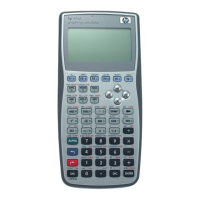3-212 Full Command and Function Reference
Input/Output:
L4/A1 L3/A2 L2/A3 L1/A4 L1/I1
lower limit upper limit integrand 'name'
→
'symb
integral
'
L = Level; A = Argument; I = Item
See also: TAYLR, ∂, Σ
? (Undefined)
CAS: The “undefined” symbol for numeric results that are not defined by the rules of arithmetic.
∞ (Infinity)
CAS: Symbol signifies infinite numeric result, such as division of a non-zero number by zero.
Σ (Summation)
Type: Function
Description: Summation Function: Calculates the value of a finite series.
The summand argument smnd can be a real number, a complex number, a unit object, a local or global
name, or an algebraic object. The algebraic syntax for Σ differs from the stack syntax. The algebraic
syntax is: 'Σ(index=initial,final,summand)'
Access: …½ (½ is the right-shift of the Skey).
Flags: Symbolic Constants (-2), Numerical Results (-3)
Input/Output:
L4/A1 L3/A2 L2/A3 L1/A4 L1/I1
'indx' x
init
x
final
smnd
→
x
sum
'indx' 'init' x
final
smnd
→
'
Σ
(indx = init, x
final
, smnd)'
'indx' x
init
'final' smnd
→
'
Σ
(indx = x
init
, final, smnd)'
'indx' 'init' 'final' smnd
→
'
Σ
(indx = init, final, smnd)'
L = Level; A = Argument; I = Item
See also: TAYLR, ∫, ∂
Σ+ (Sigma Plus)
Type: Command
Description: Sigma Plus Command: Adds one or more data points to the current statistics matrix (reserved
variable ΣDAT).
For a statistics matrix with m columns, arguments for Σ+ can be entered several ways:
• To enter one data point with a single coordinate value, the argument for Σ+ must be a real
number.
• To enter one data point with multiple coordinate values, the argument for Σ+ must be a
vector with m real coordinate values.
• To enter several data points, the argument for Σ+ must be a matrix of n rows of m real
coordinate values.
In each case, the coordinate values of the data point(s) are added as new rows to the current
statistics matrix (reserved variable ΣDAT). If ΣDAT does not exist, Σ+ creates an n x m matrix
and stores the matrix in ΣDAT. If ΣDAT does exist, an error occurs if it does not contain a real
matrix, or if the number of coordinate values in each data point entered with Σ+ does not match
the number of columns in the current statistics matrix.
Once ΣDAT exists, individual data points of m coordinates can be entered as m separate real
numbers or an m-element vector. LASTARG returns the m-element vector in either case.
Access: …µΣ+

